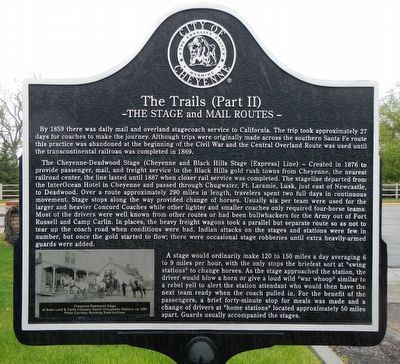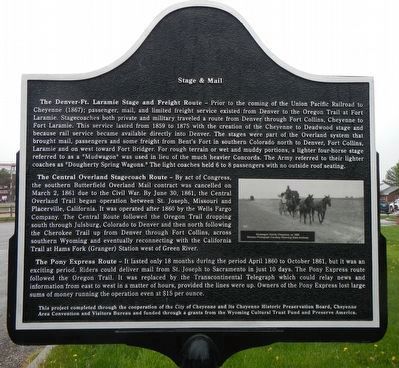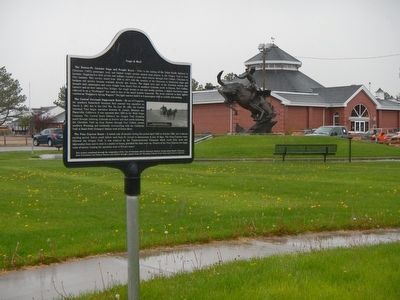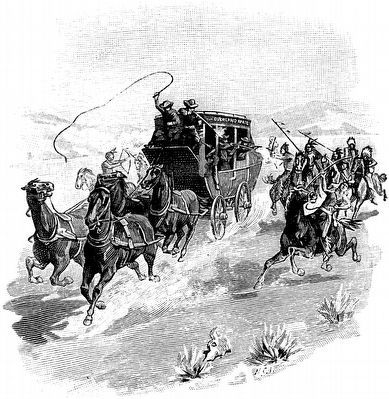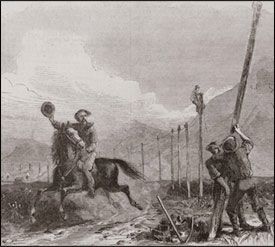Cheyenne in Laramie County, Wyoming — The American West (Mountains)
The Trails (Part II)
The Stage and Mail Routes
Inscription.
By 1859 there was daily mail and overland stagecoach service to California. The trip took approximately 27 days for coaches to make the journey. Although trips were originally made across the southern Santa Fe route this practice was abandoned at the beginning of the Civil War and the Central Overland Route was used until the transcontinental railroad was completed in 1869.
The Cheyenne-Deadwood Stage (Cheyenne and Black Hills (Express) Line) - Created in 1876 to provide passenger, mail and freight service to the Black Hills gold rush towns from Cheyenne, the nearest railroad center, the line lasted until 1887 when closer rail service was completed. The stage line departed from the InterOcean Hotel in Cheyenne and passed through Cheyenne and passed through Chugwater, Ft. Laramie, Lusk, just east of Newcastle, to Deadwood. Over a route, approximately 290 miles in length, travelers spent two full days in continuous movement. Stage stops along the way provided change of horses. Usually six per team were used for the larger and heavier Concord Coaches while other lighter and smaller coaches only required four-horse teams. Most of the drivers were well known from other routes or had been bullwhackers for the Army out of Fort Russell and Camp Carlin. In places, the heavy freight wagons took a parallel but separate route so as not to tear up the coach road when conditions were bad. Indian attacks on the stages and stations were few in number, but once the gold started to flow; there were occasional stage robberies until extra heavily-armed guards were added.
A stage would ordinarily make 120 to 150 miles a day averaging 6 to 9 miles per hour, with the only stops the briefest sort at "swing stations" to change horses. As the stage approached the station, the driver would blow a horn or give a wild "war whoop" similar to a rebel yell to alert the station attendant who would then have the next team ready when the coach pulled in. For the benefit of the passengers, a brief forty-minute stop for meals was made and a change of drivers at "home stations" located approximately 50 miles apart. Guards usually accompanied the stages.
The Denver-Ft. Laramie Stage and Freight Route - Prior to the coming of the Union Pacific Railroad to Cheyenne (1867); passenger, mail, and limited freight service existed from Denver to the Oregon Trail at Fort Laramie. Stagecoaches both private and military traveled a route from Denver through Fort Collins, Cheyenne to Fort Laramie. This service lasted from 1859 to 1875 with the creation of the Cheyenne to Deadwood stage and because rail service became available directly to Denver. The stages were a part of the Overland system that brought mail, passengers and some
freight from Bent's Fort in southern Colorado north to Denver, Fort Collins, Laramie and on west toward Fort Bridger. For rough terrain or wet and muddy portions, a lighter four-horse stage referred to as a "Mudwagon" was used in lieu of the much heavier Concords.The Army referred to their lighter coaches as "Dougherty Spring Wagon," The light coaches held 6 to 8 passenger with no outside roof seating.
The Central Overland Stage Route - By act of Congress the southern Butterfield Overland Mail contract was cancelled on March 2, 1861 due to the Civil War. By June 30, 1861, the Central Overland Trail began operation between St. Joseph, Missouri and Placerville, California. It was operated after 1860 by Wells Fargo Company. The Central Route followed the Oregon Trail dropping south through Julesburg, Colorado to Denver and then north following the Cherokee Trail up from Denver through Fort Collins, across southern Wyoming and eventually reconnecting with the California Trail at Hams Fork (Granger) Station west of Green River.
The Pony Express Route - It lasted only 18 months during the period April 1860 to October 1861, but it was an exciting period. Riders could deliver mail from St. Joseph to Sacramento in just 10 days. The Pony Express route followed the Oregon Trail. It was replaced by the Transcontinental Telegraph which could relay news and information from east to west in a matter of hours, provided the lines were up. Owners of the Pony Express lost large sums of money running the operation even at $15 per ounce.
Erected by City of Cheyenne, Cheyenne Historic Historic Preservation Board, Cheyenne Area Convention and Visitors Board, Wyoming Cultural Trust Fund and Preserve America.
Topics. This historical marker is listed in these topic lists: Communications • Roads & Vehicles.
Location. 41° 9.479′ N, 104° 50.002′ W. Marker is in Cheyenne, Wyoming, in Laramie County. Marker is on Carey Avenue near Lions Park Drive, on the left. Touch for map. Marker is at or near this postal address: 4610 Carey Avenue, Cheyenne WY 82001, United States of America. Touch for directions.
Other nearby markers. At least 8 other markers are within walking distance of this marker. The Trails (Part I) (within shouting distance of this marker); Cheyenne Frontier Days™ (Part II) (within shouting distance of this marker); The Trails (Part III) (within shouting distance of this marker); Floyd and Edna Young Folk Art Fence (within shouting distance of this marker); Union Pacific Steam Engine #1242 (within shouting distance of this marker); Cheyenne Frontier Days™ (Part I) (within shouting distance of this marker); Early Cheyenne Reservoir (about 700 feet away, measured in a direct line); Fort Laramie Trail (approx. 0.3 miles away). Touch for a list and map of all markers in Cheyenne.
More about this marker. This marker is located in front of the Cheyenne Frontier Days/Old West Museum.
Credits. This page was last revised on June 20, 2016. It was originally submitted on June 20, 2016, by Barry Swackhamer of Brentwood, California. This page has been viewed 521 times since then and 30 times this year. Photos: 1, 2, 3, 4, 5. submitted on June 20, 2016, by Barry Swackhamer of Brentwood, California.
